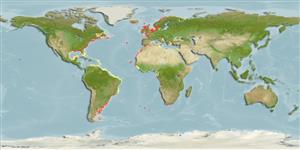Bivalvia |
Venerida |
Veneridae
Environment: milieu / climate zone / djupintervall / distribution range
Ekologi
; djupintervall 0 - 49 m (Ref. 104365). Subtropical; 52°N - 36°S, 98°W - 34°W
Western Atlantic: From Gulf of St. Lawrence to Uruguay. Introduced to Eastern Atlantic and the Mediterranean.
Length at first maturity / Size / Weight / Age
Könsmognad: Lm ? range ? - ? cm Max length : 6.5 cm SHL hane/ej könsbestämd; (Ref. 7882); common length : 4.0 cm SHL hane/ej könsbestämd; (Ref. 437)
Species' maximum length from the Belgian part of the North Sea (Ref. 7882). Estuarine (Ref. 104365). Found along coasts in fine to muddy sediment. Bores in hard clay, limestone, solidified mud, and pieces of peat and wood (Ref. 7882).
Life cycle and mating behavior
Könsmognad | Reproduktion | Lek | Eggs | Fecundity | Larvae
Members of the class Bivalvia are mostly gonochoric, some are protandric hermaphrodites. Life cycle: Embryos develop into free-swimming trocophore larvae, succeeded by the bivalve veliger, resembling a miniature clam.
Fischer, W., G. Bianchi and W.B. Scott (eds.) 1981 Bivalves. 6: pag.var. In FAO species identification sheets for fishery purposes. Eastern Central Atlantic (fishing areas 34, 47; in part). Canada Funds-in-Trust. Ottawa, Department of Fisheries and Oceans Canada, by arrangement with the Food and AgriculturesOrganization of the United Nations, 1-7: pag.var. (Ref. 437)
IUCN Red List Status
(Ref. 130435: Version 2025-1)
CITES status (Ref. 108899)
Not Evaluated
Not Evaluated
Threat to humans
Human uses
| FishSource |
Verktyg
Ytterligare information
Trophic EcologyFood items (preys)
Födosammansättning
Födointag
Predatorer
Population dynamicsTillväxt
Max. ages / sizes
Length-weight rel.
Length-length rel.
Length-frequencies
Mass conversion
Abundans
PhysiologySyreförbrukning
Human RelatedStamps, coins, misc.
Internet-källor
Estimates based on models
Preferred temperature
(Ref.
115969): 8.2 - 23.9, mean 11.2 (based on 510 cells).
Fishing Vulnerability
Low vulnerability (10 of 100).
Price category
Unknown.
